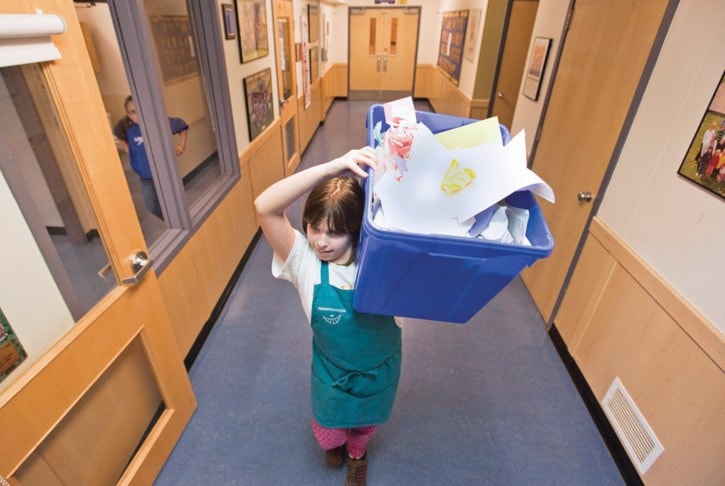A five-year-old slides an apron over his head and pulls latex gloves, blue and ill-fitting, onto his tiny hands.
One girl stomps on a pile of pizza boxes and stacks them in a blue box. Another boy pushes a bin, taller than himself and filled with various plastics, down the hall and into a bustling alcove where more young students scurry about sorting recyclables.
Just another Friday lunch hour for the Green Team at Lake Hill elementary, where 40 of 170 students participate in an effort to eliminate waste produced by the school.
Since the program launched two years ago, the Green Team, led by educational assistant Tanya Johnson, has cut the garbage produced at Lake Hill down by 75 per cent.
Paper, hard plastics, soft plastics, foil-lined packaging, compost, electronic waste – all recyclable items are collected by the students twice weekly and carefully sorted in preparation for pick up. Imagine a mad half-hour of organized chaos that feels more than a little like a busy train station.
“They’re really good at telling me,” Johnson said of how the kids in kindergarten to Grade 5 hold the other recyclers in the school accountable for bad sorting. “They notice that the staff room is the worst.”
Diligence and accountability are common themes at elementary schools where K-5s are following through with green goals set by school district planners. At Lochside elementary, students have kept up their devotion to recycling since being honoured with a CRD EcoStar award and a Youth Environmental Award from the District of Saanich.
“The kids got on board almost right away. It’s the teachers that took a bit longer,” said Christine Sanders, who teaches at Lochside elementary. In the four years since its inception, the program at Lochside has diverted 75 per cent of the school’s landfill waste.
“Some of the adults who were initially complaining about it are now the biggest converts,” Sanders said.
The Greater Victoria School District, to which Lake Hill belongs, is in the second year of a pilot project, aimed at moving all 45 elementary, middle and high schools onto a similar green program by the beginning of 2012.
To get involved, each school pitches an individual plan to the district, which supplies the school with necessary sorting receptacles. Reynolds secondary school was the first to launch the program.
Operationally, this hasn’t equated to a huge change at participating schools, which are seeing resources formally used for garbage pick up, now focused on recycling efforts.
“If there are some dollar savings along the way, the more the better from a facilities point of view, but that’s not our No. 1 criteria,” said Seamus Howley, director of facilities for the GVSD.
Operations supervisor with the district, Glenn Miller calls elementary-aged students the true champions of generational change, slated to lead the way as they move toward graduation.
“Just hang out at an elementary school if you’ve got some time and you’ll see how much the kids really do take (this) seriously and really are good learners for the program,” Miller said. “You’ll see how quick they are and how diligent they are in doing the right thing.”
nnorth@saanichnews.com



